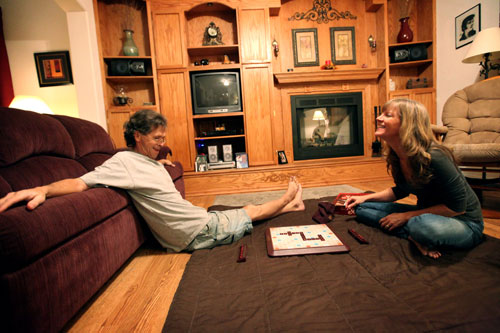America struggles to prepare for Alzheimer’s, a growing storm




Alzheimer’s disease.
Americans fear only cancer more. For those older than 65, it is the most feared diagnosis.
The reasons are many: Alzheimer’s is a progressive and fatal brain disorder with a long goodbye, one that often reduces sufferers to a quarrelsome infancy. Caregivers, most of whom are unpaid relatives, must learn compassionate ways to deal with tantrums, change adult diapers and watch a loved one practically become a stranger. The cost of care can deplete family savings for college and retirement, even driving some from their homes. And age is the greatest risk factor.
The disease, which causes dramatic problems with memory, thinking and behavior, is the sixth leading cause of death in the United States and the only one of the top 10 without an identified way to cure, prevent or even slow its progression.
Each year, Alzheimer’s, the most common form of dementia, kills more Americans than breast and prostate cancer combined.
And it’s getting worse.
"What this single disease will do in the next few decades boggles the mind, with almost 10 million baby boomers expected to die with or from Alzheimer’s," says UCLA researcher George Bartzokis. "This is one of the biggest predictable human catastrophes in the history of America."
While death rates for other major diseases, including top killer heart disease, have declined, the number of Americans who die each year from Alzheimer’s has risen 66 percent since 2000. It now kills more than 80,000 per year, including about 300 deaths annually in Nevada.
Sometimes, the stress of caring round-the-clock for a loved one with the disorder is so great that the caregiver dies first.
Every 68 seconds, someone in America develops the disease, according to the Alzheimer’s Association. There were 21,000 Nevadans with the disease in 2000 —- the association projects that number to double by 2025.
As 10,000 baby boomers in the country continue to turn 65 each day, many researchers believe the brain disorder could become the "defining disease" of the 80 million strong generation that was born between 1946 and 1964.
RESEARCH TAKES MONEY
Without research advances, William Thies, chief medical and scientific officer for the Alzheimer’s Association, says the number of Americans living with the disease is expected to jump from 5.4 million to 16 million in less than 40 years —- with costs of care projected to rise from $200 billion today to $1.1 trillion in 2050.
Yet research funding for the disease is surprisingly low, given the heartache and economic turmoil it creates.
The National Institutes of Health spends $450 million a year for Alzheimer’s research, far below the $6 billion per year for cancer research, $4 billion for heart disease research, and $3 billion for HIV/AIDS.
Larry Ruvo, the philanthropist businessman who founded the Cleveland Clinic Lou Ruvo Center for Brain Health in honor of his father, who died of Alzheimer’s, is surprised the nation’s baby boomers don’t use their huge numbers to fight for more funding.
"You’ve got to get the attention of people in government," he says.
That was the formula used by the gay community to push for an extraordinary amount of funding for research into HIV/AIDS. Within 10 years, HIV/AIDS was largely treatable.
Bartzokis, University of California, Los Angeles researcher, says the failure of baby boomer politicians to support increased research funding while often supporting indiscriminate budget cutting is tantamount to shooting themselves in the head.
"There are many promising treatment and prevention strategies that will not be investigated quickly enough," he says. "The demented boomers themselves will be an unprecedented burden to health care and society. … They don’t seem to care that they’re going to be in diapers."
How fallout from Alzheimer’s plays out in Southern Nevada is uncertain, but it is encouraging that the Cleveland Clinic Lou Ruvo Center for Brain Health has become one of the world’s top research and clinical institutions, seeing 3,314 new patients last year alone.
"I believe that within five or 10 years that we will see a drug on the market that slows the progression of the disease," said Dr. Charles Bernick, associate director at the Ruvo Center. "There are a lot of agents in clinical trials now, including a vaccine. … Many of them we’re doing here. … I feel sure one of them will hit."
It is also promising that the Nevada Legislature convened a task force to develop a state plan to address the disease, suggesting that there has to be more support for family caregivers. The Alzheimer’s Association estimates that the total value on unpaid care in Nevada is $1.8 billion per year.
In a lengthy report, the state task force recognized several challenges, including those affecting people who develop early onset Alzheimer’s, which hits about 4 percent of those with the disease.
Many of those patients, the task force noted, are denied the support and services they need, based on their age, because of different funding sources’ age requirements. The task force recommended that statutes and regulations be changed to allow these individuals to receive the same services as seniors.
Sherry Ables says it’s a good idea but probably too late for her and her husband, James, a 58-year-old construction worker who was diagnosed with the disease last year. The financial challenges from having the main breadwinner lose his job have just been too much.
"It looks like we’re going to lose our house," the Las Vegas woman says.
COMPLICATED PUZZLE
During an Alzheimer’s disease diagnosis, the doctor tells the family: "It’s a progressive, degenerative disorder." The words don’t conjure up images of the ruthless attack that will play out in a loved one’s brain.
As the disease accelerates, Alzheimer’s gradually seizes a person’s mind, stealing the cognitive abilities that permit banter with a loved one, a grin, a taste for food, a trip to the restroom.
Twenty years ago, researchers that included Dr. Jeffrey Cummings, now the director of the Ruvo Center, were sure the cause of this brain invasion was an alarming buildup of a protein called beta-amyloid. Eliminate these hulking, sticky globs and cure the disease, the logic went. Yet a string of unsuccessful studies spawned by that hypothesis has forced a re-evaluation of that strategy, with many researchers keying on the tangles of a protein called tau.
That amyloid and tau attract so much attention is hardly a surprise – foreboding deposits of plaque and tangles are what caught the eye of German physician Alois Alzheimer when he first described the disorder more than a century ago during a postmortem examination of a patient’s brain.
Cummings, one of the world’s most prolific researchers into Alzheimer’s, continues to believe amyloid has a central role in the disease, but that it may not be the most toxic component of the illness.
What is unfortunate, Cummings adds, is that he, and a growing number of researchers, believe drugs that have been shown to wipe out ominous formations in the brain could probably slow progression of the disease, but researchers can’t get them to patients soon enough.
Research indicates that deadly changes in the brain actually start 10 to 20 years before the symptoms.
By the time the patient’s dementia is diagnosed, there is already substantial brain injury, making it impossible for the drugs to work, he says.
"We need a diagnosis at earlier phases of the disease," Cummings says.
Think of the problem this way, researchers suggest. If you wait for someone to have five heart attacks and he’s in heart failure, it’s probably too late to give him the cholesterol lowering medication Lipitor.
New imaging scans, Cummings says, could soon be a game changer in terms of identifying future Alzheimer’s sufferers and allowing researchers to develop more specific populations for interventions.
It took years before Toni Wombaker of Pahrump could get a correct diagnosis for her mother, Yvonne Jensen, who is now in the latter stages of the disease. How Wombaker wishes there had been an intervention for her.
"Each and every day my soul hurts," Wombaker wrote in her journal. "I feel a sadness like I’ve never felt before, and a part of me feels hollow. I have a very hard time looking at my mom, looking into her eyes, because the person I see looks like my mom, smiles like my mom, sounds like my mom, but I am devastated to say, my Alzheimer’s mom is a very different person than I have ever known my mom to be."
COULD ANSWER BE HERE?
It seems incredible that one of the best places on Earth to address questions about a growing medical epidemic is a research center built on an abandoned railroad yard in downtown Las Vegas, a city better known for a major hepatitis outbreak and several cases of medical fraud.
Audacious even by Las Vegas standards, founder Larry Ruvo expects the Ruvo Center to be the world leader in Alzheimer’s clinical care and research.
Designed by celebrated architect Frank Gehry, the center, which opened in 2009, features a twisted, stainless steel skin that could easily be interpreted as symbolic of a brain gone off the rails. It houses researchers and clinicians using the latest imaging technology with patients, hoping to learn more about the abnormal lesions, amyloid plaques and tau tangles.
Today, it is not uncommon to find the Mayo Clinic’s Dr. Ronald Petersen, who diagnosed President Reagan’s Alzheimer’s disease, attending conferences at the center alongside world-renowned physicians that may include: Dr. Philip Scheltens, head of a prestigious brain center in the Netherlands; Dr. Colin Masters, head of the leading brain institute in Australia; and Drs. Bruno Vellas and Jacques Touchon, the top Alzheimer’s researchers in France. Dr. Stanley Prusiner, a Nobel Prize laureate, heads the scientific advisory board at the Ruvo Center.
Cummings points out that the Ruvo Center, with more than 20 clinical studies under way, already leads the nation in the number of studies conducted.
"It only stands to reason that the more trials of drugs you have, the better chance you have of finding those that really work," he says.
Studies at the Ruvo Center and at other research institutions suggest a trait called cognitive reserve can help explain why certain people are able to stay mentally sharper longer than others. The term applies to the brain’s ability to cope with damage, such as the plaque that clogs the brain in Alzheimer’s, while still functioning normally.
A life full of mentally challenging activities, such as pursuing an education, working at a stimulating job and meaningful volunteering – including during the later years in life when many people choose to passively "retire" – may contribute to building cognitive reserve, research shows.
"It seems to me that the question of retirement and Alzheimer’s has to be an important part of the dialogue into slowing down onset of the disease," Cummings says.
"The logical extension of the data we have on dementia is that a person who is still capable of working, who is mentally stimulated with a strong sense of purpose, is better off from the cognitive point of view continuing to engage in that position."
A voracious reader of Alzheimer’s research, Ruvo often sends friends a bottle of Brain Armor, a DHA supplement, with the latest news from the Ruvo Center. DHA, or docosahexaenoic acid, has been shown in some studies to reduce inflammation, combat the plaque buildup associated with Alzheimer’s and increase blood flow to the brain.
When Ruvo’s father started exhibiting signs of Alzheimer’s in the ’90s, it took nearly two years of misdiagnoses and doctor visits in Las Vegas before he was finally diagnosed in California. Angie Ruvo, Lou’s wife and caregiver, ruptured two discs in her back caring for him, requiring her to have surgery and leaving her nearly unable to walk.
That troubling experience turned out to be the fundraising catalyst for the center, which Ruvo worked into a partnership with the renowned Cleveland Clinic.
Ruvo continues to raise tens of millions of dollars for brain research, including the annual Power of Love gala fundraiser, which in 2011 honored Muhammad Ali, who suffers with Parkinson’s disease.
In the near future, Ruvo, whose ideas on financing Alzheimer’s research are listened to in Washington, expects to see a national telethon raising funds for the disease.
"The investment has to be much greater to get things moving faster," says Ruvo, who worries that some drug companies are pulling back on investments in drug research, making a major public-private partnership in research all the more important.
Researchers Heather Snyder and William Thies, key members of the medical and scientific advisory council of the Chicago-based Alzheimer’s Association, agree with Ruvo, saying that scrimping on research funding is only going to allow the epidemic to create more havoc for the nation both in economic and human terms.
"There has to be a strong commitment by the government if we want to make a big difference in treatment of this disease," Snyder says.
The vast majority of the research community, including Snyder, Thies and Cummings, does not think much of a position taken by a group of researchers from the University of South Florida, who submit that Alzheimer’s is an inevitable part of aging, along with heart disease, osteoporosis and wrinkles.
"That’s simply not what the research holds," Thies says.
In May, the Obama administration announced the launch of the National Alzheimer’s Plan, with the goal of finding effective ways to prevent and treat the devastating effects of dementia by 2025.
Earlier this year, President Obama invested $50 million in new research funding and promised another $80 million for research in 2013. Even that is not enough to stem the rising tide of Alzheimer’s disease that is facing America’s aging population.
"It’s not what is needed," Ruvo says.
Contact reporter Paul Harasim at pharasim@reviewjournal.com or 702-387-2908.
FINDING HELPThese are local organizations that help people with Alzheimer’s disease and their families. Some accept volunteers.
Alzheimer’s Association, Desert Southwest Chapter, Southern Nevada Region
The association offers general information, support groups, educational programs, referrals and opportunities to volunteer.
Address: 5190 S. Valley View Blvd., Suite 104, Las Vegas, NV 89118
Phone: 702-248-2770
24-hour Helpline: 800-272-3900, operates seven days a week, in 140 languages
Cleveland Clinic Lou Ruvo Center for Brain Health
Address: 888 W. Bonneville Ave., Las Vegas, NV 89106
Phone: 702-331-7054
Appointments: 702-483-6000, Option 2
Information about services and programs for caregivers and families: 702-483-6023
Information about enrolling in a clinical trial: 702-685-7073 or brainhealth@ccf.org
Donations: Cleveland Clinic Lou Ruvo Center for Brain Health Philanthropy Institute, 702-331-7052
Volunteer: 702-331-7046
Keep Memory Alive: 702-263-9797
Alzheimer’s Disease: A Rising Storm
The Review-Journal presents a series about Alzheimer’s disease and its impact on society, today and potentially in the future.
Today
• The financial impact of the disease on families and society
UPCOMING:
Monday
• Challenges for the 80 percent of Americans who choose to care for their loved ones with Alzheimer’s disease at home
• Alternative forms of care, from day care to assisted living and nursing homes
Tuesday
• Identification and treatment of Alzheimer’s disease
Wednesday
• Debate about the benefits of testing for Alzheimer’s
Thursday
• The state of Alzheimer’s research and what is needed in the future


















